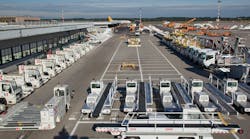As airports and transit agencies across the country ramp up their capital improvement programs, it opens the opportunity for creating or expanding their asset management programs. A capital improvement program is the perfect time to capture asset inventory data and use it to populate a new asset management system or expand an existing system because it is a much more efficient approach than doing it after the fact.
Incorporating asset identification and clarification into the planning, design and construction of new terminals and facilities can reduce costs and save time with data capture.
Using building information modeling and related technologies in tandem with incorporating an asset management framework, construction of a facility can also result in an up-to-date “virtual” asset management tool for operation and maintenance.
Enterprise asset management (EAM) is a strategic, systematic process of operating, maintaining, upgrading and expanding physical assets effectively throughout their life cycles. By incorporating business and engineering practices, airports and public agencies can more effectively plan and deploy capital investments. The result is better decision-making based on quality information and well-defined objectives, which can lead to enhanced customer service for both passengers and airlines, and significant financial benefits through improved life-cycle cost decision-making.
At the heart of an effective airport enterprise asset management system is the underlying data, which can be a very data-intensive process. Incorporating technology to manage data provides executives a
framework from which to make more informed decisions, such as:
- Planning asset improvements, operations and maintenance
- Prioritizing projects to determine how best to spend current budgets for the greatest return on investment
- Extending life cycles through increased focus on preventative maintenance and operations
- Improving capital planning by anticipating and budgeting for future repairs and replacements
Effective enterprise asset management programs require a systematic approach and careful planning. Following are steps airports can take to achieve a more holistic, cross-functional approach.
1. Set the vision and provide management support
Senior leadership should communicate the vision of approaching asset management more holistically to ensure all assets meet established customer service levels.
2. Guide the effort with a cross-functional implementation team
Utilize a cross-functional steering committee because an EAM requires significant information sharing as well as a mutual understanding and agreement on priorities, methods, commitments and expected results.
3. Provide a dedicated program manager
A program manager with proper qualifications and a fresh perspective can provide the additional expertise, insight and momentum the airport may need to move the program forward effectively.
4. Design a systematic asset management plan
An asset management system should be designed to integrate activities across functional areas and to combine business unit and operations data into an organization-wide, aggregated analysis. EAM implementation is not a small effort. It can dramatically impact current planning, operations
and maintenance activities.
5.Create policies and procedures to manage data and workflows that will feed into the new system
The ISO 55000 series, and the former PAS55 guidelines, have emerged as guiding principles and best practices for asset management implementation. Other guidance includes the Airports Cooperative Research Program Report: Asset and Infrastructure Management for Airports and the TAM Infrastructure Performance Measure Reporting Guidebook from the Federal Transit Administration.
6. Identify the software package or vendor to best support the policies and processes
There are many technology platforms and strategies that can best support an enterprise asset management approach. Basing selection on user needs and leveraging current technology portfolios will align the eff ort with success.
7. Collect, interpret and maintain data
Through strategic data collection and interpretation, airports address the assets themselves and their life-cycle costs, creating rehabilitation or reconstruction investment scenarios to see how those scenarios impact the overall system and current budget constraints.
8. Conduct an incremental rollout
Identify and pursue early wins to maintain momentum and strengthen the case for an enterprise asset management system.
9. Incorporate tools that build a supportive culture
Ask agency leaders to communicate the benefits of EAM to employees. Have them talk about the greater operational efficiencies, improved emergency response, increased asset knowledge and more informed decision-making and EAM system can provide.
10. Incorporate digital tools to promote ease of use in the field
Using different mobile device options, staff can efficiently capture inspection data and corresponding evidence with the aid of photos, voice memos and inspection ratings. It allows field and office staff to effectively review inspection data, generate work orders that assign maintenance and repair tasks to its workforce and track the history and status of each comment and work order.
11. Settle in
A successful asset management program is typically a long-term engagement that results in continuous organizational improvement. As the system matures, beware of scope creep and distractions. Priorities can change, but they must align with goals outlined in the strategic plan.
It’s not about learning how to take better care of their assets. EAM is about how to maintain the appropriate level of service, given an increasing number of financial and resource constraints.
Implementing an EAM approach is an important strategic investment for airports that directly supports an airport’s fundamental mission of providing safe, reliable transportation.
Jeff Siegel, GISP, in a vice president and regional practice leader of information technology services for HNTB Corporation. He has more than 23 years of experience in the implementation of information technology solutions related to infrastructure planning, design, operations and maintenance – from large program control solutions to client-based enterprise geographic information systems and asset management solutions. Contact him at [email protected] or (312) 930-9119.





